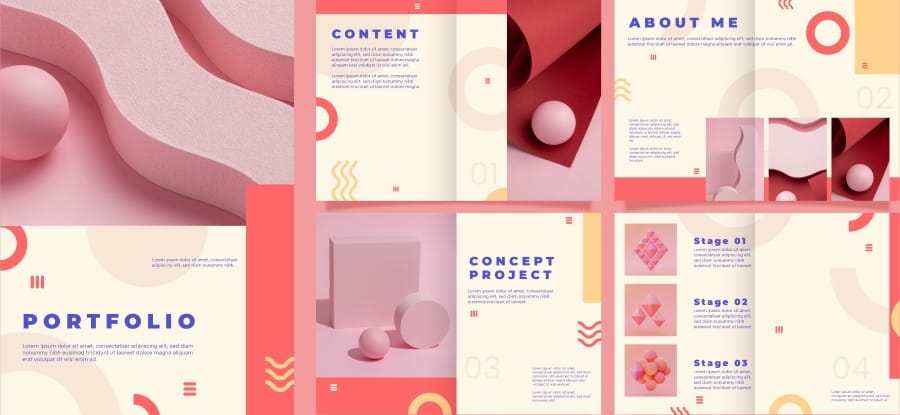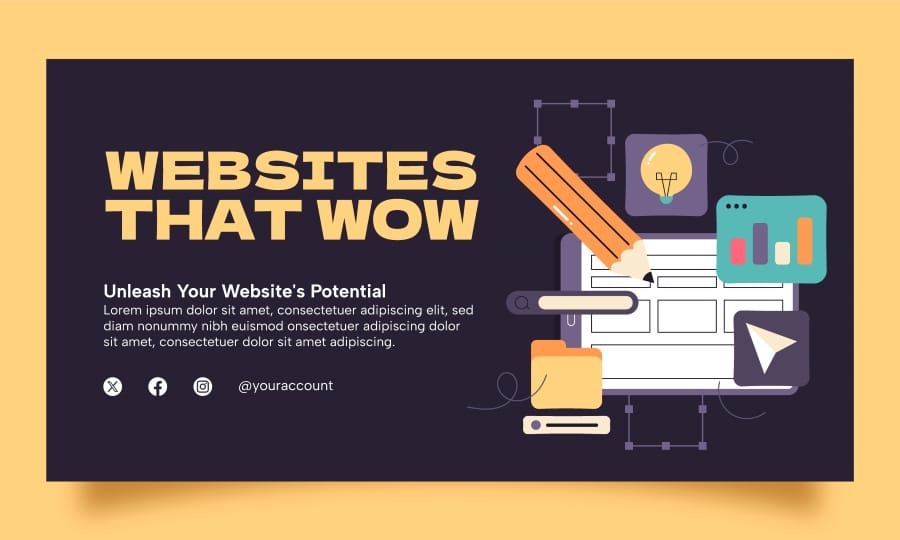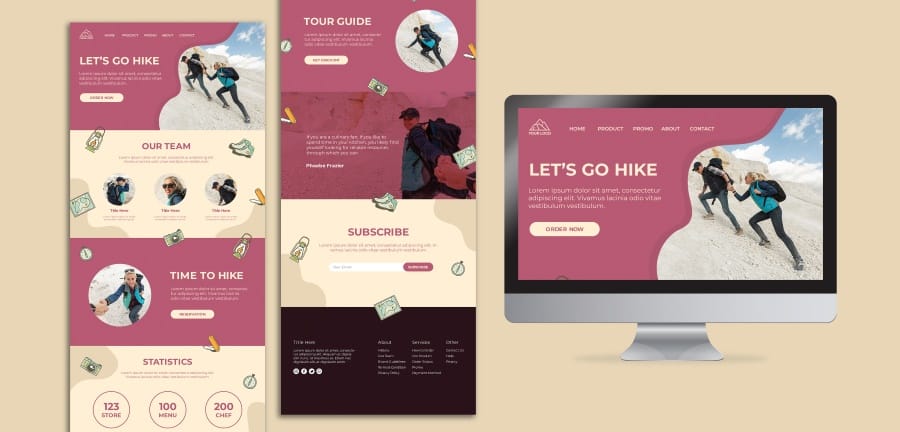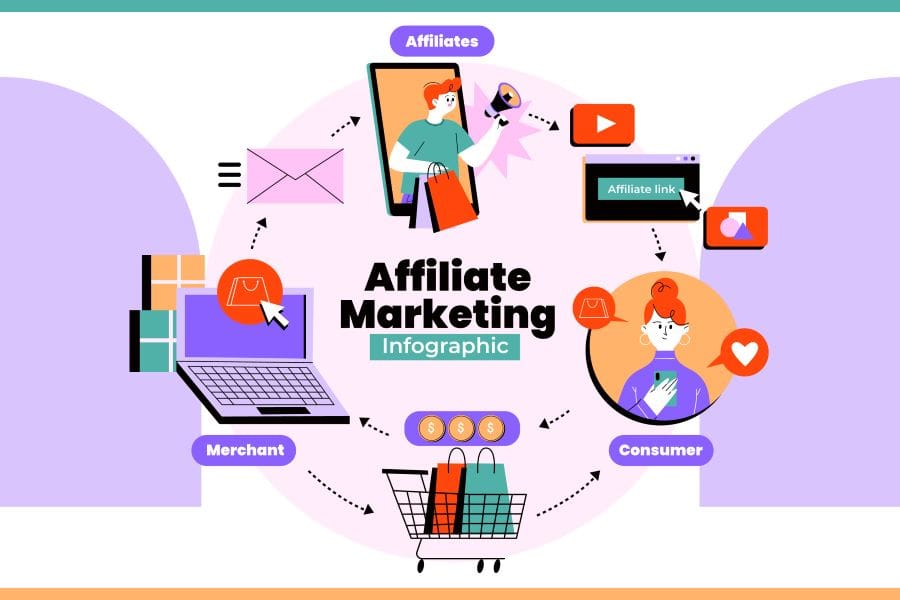Maximize Your Web Design Earnings: 12 Proven Ways to Earn Money Online in 2025
Web design continues to thrive as one of the most lucrative fields in the digital economy. In 2025, the opportunities to turn your skills into a sustainable income have expanded even further. Whether you’re a beginner or a seasoned professional, there’s a niche for everyone. We explore why becoming a web designer is a smart career move and 12 practical ways to make money in the web design industry this year.
Why Pursue Web Design in 2025?
- The demand for skilled web designers remains strong, thanks to the ever-growing need for businesses to establish an online presence. Here are some key reasons why web design is a smart career choice in 2025:
- High Demand: The proliferation of e-commerce and digital businesses means there’s no shortage of work.
- Flexibility: Work remotely, set your hours, and take on projects that align with your interests.
- Lucrative Earnings: With experience, web designers can charge premium rates for their services.
- Creative Outlet: Web design combines technical skills with artistic creativity, offering a fulfilling career path.
12 Ways to Make Money from Web Design
1- Freelance Web Design
Freelancing is one of the most flexible and accessible ways to start your web design career. As a freelancer, you have the freedom to choose your clients, set your rates, and work on projects that align with your skills and interests. Here’s how to excel as a freelance web designer in 2025:
Key Platforms for Freelancers
Platforms like Upwork, Toptal, Guru, and 99designs remain popular hubs for finding clients. Additionally, newer platforms like Workchest, and We Work Remotely focus on connecting freelancers with quality clients. By maintaining a profile on multiple platforms, you can maximize your visibility and attract a wider range of projects.
Building Your Portfolio
A strong portfolio is your ticket to attracting high-paying clients. Here’s how to enhance your portfolio:
- Showcase Variety: Include projects from different industries to demonstrate versatility.
- Highlight Your Skills: Provide case studies that explain the challenges, your approach, and the results you achieved.
- Update Regularly: Keep your portfolio up to date with your latest and best work. Tools like Behance, Dribble, or a personal website can be excellent for this.

Attracting Clients
- Specialize in a Niche: Position yourself as an expert in specific industries like e-commerce, healthcare, or education to stand out in a crowded market.
- Offer Competitive Pricing Initially: While starting, set reasonable rates to build your reputation. Gradually increase your fees as you gain positive reviews and experience.
- Network Actively: Use social media platforms like LinkedIn, participate in design forums, or join communities like Designer Hangout to connect with potential clients.
Managing Freelance Work Efficiently
Freelancing requires juggling multiple responsibilities, including client communication, project management, and finances. Use tools like:
- Trello or Asana for project management.
- HoneyBook or Bonsai for contracts, invoicing, and client communications.
- Slack for real-time updates with clients.
Upskilling and Staying Competitive
To stay ahead of the curve, continuously update your skills. Familiarize yourself with the latest web design trends, tools, and technologies, such as AI-powered design tools or interactive animations.
Expanding Beyond Platforms
While freelance platforms are a good starting point, build your brand to attract clients directly. A professional website, SEO-optimized blog, and social media presence can help establish authority and reduce dependency on third-party platforms.
Building Long-Term Relationships
Repeat clients are invaluable in freelancing. Deliver exceptional work, communicate effectively, and offer additional services like maintenance or redesigns to build loyalty and secure long-term contracts.
By following these strategies, freelancing can become more than a side gig—it can evolve into a full-fledged, profitable career path. The key is to start small, stay consistent, and continually refine your craft.
2- Launch a Web Design Agency
Transitioning from a solo freelance career to running a web design agency is a powerful way to scale your business and increase your impact. By collaborating with other professionals, you can offer a full spectrum of services, attract bigger clients, and handle more complex projects. Here’s a comprehensive guide to successfully launching your web design agency:
Why Start a Web Design Agency?
- Broader Services: Combine web design with development, SEO, branding, and digital marketing for a comprehensive client offering.
- Larger Projects: Agencies can bid for higher-value contracts and work with larger organizations that require a team-based approach.
- Scalability: An agency model allows you to grow your client base without being constrained by your capacity.

Steps to Launch Your Agency
1. Establish Your Niche
Identify a target audience or industry to focus on. Specializing in e-commerce, SaaS platforms, or nonprofit websites can set you apart from generalist agencies.
- Example niches: “Luxury brands,” “Healthcare providers,” or “Tech startups.”
2. Build a Strong Brand
Your agency needs a professional identity that reflects credibility and creativity. Key elements include:
- Agency Name and Logo: Choose a memorable name that resonates with your target audience.
- Website: Create a visually appealing, SEO-optimized site showcasing your team, services, and portfolio.
- Social Media Presence: Use platforms like Instagram, LinkedIn, and Twitter to promote your agency and engage with potential clients.
3. Assemble a Skilled Team
To offer comprehensive services, recruit experts in complementary fields, such as:
- Web developers for backend functionality.
- Graphic designers for branding and visual assets.
- SEO and digital marketing specialists to optimize websites and drive traffic.
Ensure your team has diverse skills but shares a common vision for delivering high-quality results.
4. Develop a Service Suite
Outline the services your agency will provide. Examples include:
- Website design and development.
- UI/UX design audits and enhancements.
- Ongoing website maintenance and updates.
- Custom branding, including logos and visual identities.
- Digital marketing, such as SEO, PPC campaigns, or content strategy.
5. Create Scalable Processes
Efficient systems are vital for managing multiple clients and projects. Use tools like:
- Project Management: Asana, Trello, or Monday.com to track progress and deadlines.
- Communication: Slack or Microsoft Teams for internal and client communication.
- Time Tracking and Billing: Toggl or Harvest to monitor your and invoice clients seamlessly.
6. Develop a Marketing Strategy
To attract clients, you’ll need an effective marketing plan. Consider:
- Content Marketing: Publish blog posts, case studies, and success stories to showcase expertise.
- Networking: Attend industry events, webinars, and local meetups to connect with potential clients.
- Paid Advertising: Use Google Ads and social media ads to target specific client demographics.
7. Build Strategic Partnerships
Collaborate with other agencies or freelancers offering complementary services, like video production or app development. These partnerships can help you expand your offerings and increase referrals.
8. Focus on Client Retention
Loyal clients are a steady source of revenue. Offer ongoing support plans, loyalty discounts, or bundled services to keep them engaged with your agency.
Challenges to Anticipate
Launching an agency comes with challenges, such as managing cash flow, handling client expectations, and scaling your team. Mitigate these risks by:
- Building a financial cushion for initial expenses.
- Setting clear client contracts with defined deliverables and timelines.
- Hiring gradually to ensure quality and maintain control over your operations.
Success Tip: Start Small and Grow
You don’t need a massive team or office space to begin. Start as a small team of trusted collaborators and grow as your client base expands. Focus on delivering exceptional results to build your reputation and attract referrals.
By scaling up to a web design agency, you can create a thriving business that leverages the talents of a team and delivers greater value to clients. The growth potential is enormous, and with careful planning, your agency can become a leading player in the digital space.
3. Leverage Website Builders
Website builders like Divi, Elementor, and Webflow have revolutionized web design by making it faster and more accessible. By mastering these tools, you can efficiently create professional, responsive websites tailored to your clients’ needs. This approach allows for saving time while offering high-quality results, even for clients with smaller budgets. Here’s how to leverage website builders effectively in 2025:
What Makes Divi and Similar Builders Ideal?
- Ease of Use: Drag-and-drop interfaces make designing websites intuitive, even for those with minimal coding experience.
- Customizability: Builders like Divi allow you to create highly customized layouts with advanced design features.
- Responsive Design: Automatically adjust designs for mobile, tablet, and desktop views.
- Time-Saving: Pre-designed templates and modules speed up the design process, allowing you to handle more projects simultaneously.
How to Maximize Your Success With Website Builders
1. Become a Certified Expert
- Gain certifications or complete specialized training in tools like Divi, Elementor, or Webflow to build credibility.
- Use this expertise as a unique selling point when marketing your services.
2. Offer Cost-Effective Packages
Website builders are perfect for clients with limited budgets who still want professional designs. Create tiered packages that include:
- Pre-built templates tailored to specific industries.
- Basic website setup and customization.
- Add-ons like SEO optimization, speed enhancements, or integrations with third-party tools.
3. Focus on Specific Niches
Specializing in a niche can help you stand out. Examples include:
- Local Businesses: Use website builders to create affordable sites for small businesses like restaurants, salons, or retail stores.
- E-commerce Stores: Leverage WooCommerce integrations within Divi to build beautiful online stores quickly.
- Personal Brands: Help influencers, freelancers, and professionals build sleek portfolio websites.
4. Create Customizable Templates
Design templates specifically for industries or types of businesses and sell them as standalone products. Platforms like TemplateMonster, Creative Market, or your website can serve as marketplaces.
5. Upsell Advanced Features
While website builders handle most design needs, you can upsell advanced services like:
- Custom Coding: For unique features that go beyond the builder’s capabilities.
- Integrations: Connect CRM systems, email marketing platforms, or booking systems.
- Enhanced Performance: Optimize speed and SEO to ensure websites rank well and perform smoothly.
6. Master Workflow Optimization
Use website builders’ tools and plugins to speed up workflows:
- Reusable Modules: Save commonly used elements (e.g., headers, footers) to reuse across projects.
- Theme Builders: Develop entire themes with predefined settings for fonts, colors, and layouts.
- Plugins and Extensions: Enhance functionality with tools like sliders, pop-ups, and advanced forms.
7. Provide Ongoing Support and Maintenance
Offer post-launch services to ensure client websites remain updated and secure. This can include:
- Updating themes, plugins, and website content.
- Troubleshooting issues or making minor design changes.
- Offering hosting and backups as part of a package deal.
Tips for Success With Divi and Website Builders
- Stay Updated: Builders like Divi and Webflow regularly release updates and new features. Stay ahead by learning and adapting to these changes.
- Showcase Your Work: Highlight builder-based projects in your portfolio to demonstrate the quality and versatility you can achieve.
- Leverage Communities: Join Divi, Elementor, or Webflow forums and social media groups to network, learn tips, and stay updated on trends.
By leveraging website builders like Divi, you can cater to a wide range of clients efficiently and affordably. These tools are especially powerful for small businesses and startups looking for professional designs without the complexity or expense of custom coding. With the right approach, you can streamline your workflow, attract clients, and scale your web design business effectively.
4. Sell Website Templates and Themes
Selling website templates and themes is an excellent way to generate passive income from your web design skills. By creating high-quality, user-friendly designs, you can reach a global market of buyers who need ready-made solutions for their websites. Here’s how to maximize your success in this area in 2025:
Why Selling Templates and Themes is Profitable
- Passive Income: Once created, templates can be sold repeatedly with minimal ongoing effort.
- Global Reach: Marketplaces like ThemeForest, TemplateMonster, and Creative Market connect you with buyers worldwide.
- High Demand: Businesses, bloggers, and entrepreneurs often prefer pre-designed templates for affordability and quick setup.
- Scalability: You can create templates for multiple platforms, such as WordPress, Shopify, or HTML, to expand your customer base.
Steps to Create and Sell Website Templates
1. Choose a Platform to Focus On
Decide which platforms or CMS your templates will target. Popular choices include:
- WordPress: Themes for blogs, portfolios, and e-commerce sites (e.g., WooCommerce themes).
- Shopify: Templates for online stores in industries like fashion, electronics, and beauty.
- HTML/CSS Templates: Simple, lightweight templates for developers and small businesses.
- Other Builders: Themes for platforms like Squarespace or Webflow.
2. Identify Market Needs
Study current trends to design templates that resonate with buyers:
- Niche-Specific Designs: Create themes tailored for industries like health, real estate, or travel.
- Trendy Features: Add dark mode options, minimalist layouts, or parallax scrolling effects.
- Responsive and Fast: Ensure templates are mobile-friendly, SEO-optimized, and load quickly.
3. Design High-Quality Templates
Focus on creating professional and polished designs:
- User-Friendly Layouts: Ensure easy navigation and intuitive UI/UX.
- Customization Options: Include options for changing fonts, colors, and layouts without coding.
- Documentation and Support: Provide clear instructions for installation and customization to increase buyer satisfaction.
4. Select the Right Marketplace
Choose a marketplace based on your target audience and design type:
- ThemeForest: Ideal for selling premium WordPress themes and templates.
- Creative Market: A popular platform for diverse templates, from websites to graphics.
- TemplateMonster: Offers a wide variety of website templates, including HTML, WordPress, and CMS-based designs.
Alternatively, sell directly from your website to keep more of your profits and build your brand. Use tools like Easy Digital Downloads or WooCommerce to manage sales.
5. Leverage Licensing Models
Offer multiple licensing options to cater to different buyers:
- Single Use License: For personal or small business use.
- Extended License: For agencies or developers who plan to use the template for multiple clients.
Strategies to Maximize Sales
1. Market Your Templates Effectively
- Social Media: Showcase your designs on Instagram, Pinterest, and LinkedIn.
- Content Marketing: Write blog posts or tutorials demonstrating the benefits of your templates.
- Paid Ads: Use Google Ads or social media ads to drive traffic to your product pages.
2. Bundle Templates
Create value-packed bundles of related templates. For example, an e-commerce bundle could include a WordPress theme, product page design, and email templates.
3. Partner With Influencers
Collaborate with influencers in the web design space to promote your templates. They can review or showcase your designs to their audience.
4. Continuously Update Templates
Keep your templates relevant by updating them with new features, improved compatibility, and bug fixes. Buyers value ongoing support and fresh designs.
5. Expand Into Plugins or Add-ons
If you’re successful with templates, consider creating complementary products like plugins, modules, or additional page layouts to upsell to your buyers.
Tips for Long-Term Success
- Consistency is Key: Regularly release new templates to keep your portfolio fresh and appealing.
- Build a Personal Brand: Create a recognizable style or focus on a specific niche to build loyal customers.
- Analyze Performance: Use analytics tools on marketplaces to track which designs perform best and tailor your future templates accordingly.
By focusing on quality, innovation, and market demand, selling website templates and themes can become a steady and scalable income stream. Whether you target WordPress users, Shopify merchants, or general businesses, the key is to create solutions that simplify and enhance the web-building experience for your customers.
5. Create and Sell Online Courses
Sharing your web design expertise through online courses is an excellent way to monetize your skills while helping others succeed. With the demand for digital skills like web design continuing to rise, online courses can provide a scalable income source and establish you as an authority in the field. Here’s how to make the most of this opportunity in 2025:
Why Create Online Courses on Web Design?
- High Demand: Beginners and professionals alike are eager to learn web design basics, advanced techniques, and new tools.
- Scalable Income: Once created, online courses can generate revenue indefinitely with minimal maintenance.
- Global Reach: Platforms like Teachable, Udemy, and Skillshare connect you with learners worldwide.
- Authority Building: Teaching establishes your credibility as a leader in the web design industry.
Steps to Create and Sell Online Courses
1. Identify Your Niche
Focus on topics that align with your expertise and cater to market demand. Examples include:
- Web Design Basics: Perfect for beginners looking to start their careers.
- Advanced Techniques: Teach responsive design, advanced CSS animations, or JavaScript integration.
- Tool-Specific Tutorials: Focus on platforms like Figma, WordPress, Webflow, or Elementor.
- Specialized Courses: E.g., how to design for e-commerce, create accessible websites, or optimize for SEO.
2. Define Your Target Audience
Understand your audience’s skill levels, goals, and challenges. Tailor your course to meet their needs, whether they’re beginners, intermediate learners, or advanced designers seeking to upskill.
3. Plan and Structure Your Course
Break down your course into clear, manageable modules. A good course structure might include:
- Introduction: Overview of what learners will achieve.
- Foundations: Key principles or basic skills.
- Practical Applications: Step-by-step tutorials or case studies.
- Project Work: Encourage learners to build a real-world project.
- Conclusion: Summarize and provide the next steps or resources.
Include quizzes, assignments, and downloadable resources (e.g., templates, and guides) to enhance engagement.
4. Choose the Right Platform
Decide where to host your course. Popular options include:
- Teachable: Offers full control over pricing, branding, and user experience.
- Udemy: Provides access to a vast audience but takes a share of your revenue.
- Skillshare: Works on a subscription model, paying based on the time learners spend on your course.
- Kajabi: A premium platform that combines course hosting with marketing tools.
Alternatively, host courses on your website using tools like LearnDash or Thinkific for maximum control and profit.
5. Create High-Quality Content
Invest in professional-grade course materials:
- Video Lectures: Use tools like Camtasia or Adobe Premiere Pro to record and edit engaging videos.
- Screen Recording: Demonstrate design processes with tools like Loom or OBS Studio.
- Audio Quality: Use a good microphone and ensure clear, noise-free audio.
- Visuals and Slides: Use Canva or PowerPoint for creating clean and professional slide decks.
Ensure your content is concise, visually appealing, and easy to follow.
Strategies to Market Your Online Course
1. Build a Personal Brand
Establish yourself as an expert by sharing your knowledge through blogs, social media posts, and YouTube videos. This attracts potential learners and builds trust.
2. Leverage Social Media
Promote your course on platforms like LinkedIn, Instagram, and Twitter. Use design-focused communities on Reddit, Facebook Groups, and Discord to reach your target audience.
3. Offer Free Previews
Provide a free introductory module or webinar to entice learners. Showcasing value upfront increases enrollment rates.
4. Run Ads
Invest in targeted ads on platforms like Google, Facebook, or Instagram to reach a broader audience.
5. Collaborate With Influencers
Partner with web design influencers to promote your course. They can review or recommend your course to their audience.
Tips for Long-Term Success
- Update Regularly: Web design trends and tools evolve quickly. Keep your course content relevant by incorporating new techniques and tools.
- Engage With Learners: Respond to questions, provide feedback on assignments, and create a community to enhance learning.
- Expand Your Offerings: Create follow-up courses or additional resources like eBooks and templates to upsell to existing students.
- Offer Certifications: Providing a certificate of completion can add value to your course and attract more learners.
By creating and selling online courses, you can turn your web design knowledge into a steady stream of income while inspiring others to enter the field. With a well-structured course and effective marketing strategy, you’ll be well-positioned to thrive in the growing e-learning market of 2025.
6. Offer Web Maintenance Services
Building a website is just the beginning of a client’s journey; maintaining it is an ongoing necessity. Websites require regular updates, security checks, performance optimizations, and backups to function smoothly. Offering web maintenance services is a practical way to establish a steady income stream and build long-term client relationships. Here’s how to enhance your web maintenance offering in 2025:
Why Web Maintenance Services Are Valuable
- Security: Regular updates protect websites from vulnerabilities and cyberattacks.
- Performance: Optimized websites ensure fast loading speeds and seamless user experiences.
- Reliability: Scheduled backups prevent data loss and provide peace of mind for clients.
- Convenience: Clients often lack the expertise or time to handle ongoing website upkeep, making this service indispensable.
Key Components of Web Maintenance Services
1. Software and Plugin Updates
- Ensure that the website’s CMS (e.g., WordPress, Joomla) and plugins are updated to the latest versions.
- Prevent compatibility issues by testing updates in a staging environment before applying them live.
2. Security Monitoring and Enhancements
- Regularly scan for malware using tools like Sucuri or MalCare.
- Implement robust security measures such as SSL certificates, firewalls, and two-factor authentication (2FA).
- Monitor traffic for suspicious activity and provide real-time threat detection.
3. Performance Optimization
- Regularly optimize images, clean up databases, and use caching tools to maintain fast loading speeds.
- Ensure that the website is mobile-responsive and meets Core Web Vitals benchmarks.
4. Backups
- Schedule automatic backups using tools like UpdraftPlus, BackupBuddy, or VaultPress.
- Store backups securely on cloud platforms like Google Drive, AWS, or Dropbox.
5. Content Updates
- Assist clients with minor content changes, such as adding blog posts, updating team pages, or revising contact details.
- Optimize new content for SEO, ensuring consistent performance in search rankings.
6. Uptime Monitoring
- Use tools like Pingdom, Uptime Robot, or StatusCake to monitor website availability.
- Provide immediate support to resolve downtime issues.
- Analytics and Reporting
- Regularly review website analytics and performance metrics using Google Analytics or similar tools.
- Offer insights and recommendations to improve traffic, user engagement, and conversion rates.
How to Structure Your Web Maintenance Plans
1. Offer Tiered Packages
Create different levels of service to suit a variety of client needs:
- Basic Plan: Essential updates, backups, and security monitoring.
- Standard Plan: Includes performance optimization and uptime monitoring.
- Premium Plan: Adds advanced features like SEO audits, content updates, and priority support.
2. Include Transparent Pricing
Price your services competitively based on the complexity and scope of maintenance. For example:
- Basic Plan: $50/month.
- Standard Plan: $100/month.
- Premium Plan: $200+/month.
Offer discounts for annual subscriptions to encourage long-term commitments.
3. Bundle With Other Services
Combine maintenance services with web design, hosting, or SEO packages to provide an all-in-one solution. This increases your revenue per client and simplifies management for your customers.
Tools to Streamline Maintenance Services
- ManageWP: A comprehensive tool for managing multiple WordPress sites, including updates, backups, and performance checks.
- InfiniteWP: Similar to ManageWP, offers centralized management for multiple websites.
- Jetpack: A WordPress plugin for backups, security, and performance enhancements.
- Google Search Console: For monitoring website health, indexing, and search performance.
Marketing Your Web Maintenance Services
1. Educate Clients on the Importance of Maintenance
Many clients underestimate the risks of neglecting website upkeep. Use blog posts, social media content, or email campaigns to highlight potential issues like security breaches, slow performance, and lost revenue from downtime.
2. Offer Free Audits
Provide a free initial audit to showcase the value of your maintenance services. Highlight areas that need improvement and offer a tailored plan to address them.
3. Build Long-Term Relationships
Position yourself as a trusted partner, not just a service provider. Regular communication, clear reporting, and proactive recommendations can help you maintain long-term clients.
4. Promote Testimonials and Case Studies
Showcase success stories of clients who benefited from your maintenance services. Positive reviews and measurable results can build trust and attract new customers.
Expanding Beyond Basic Maintenance
Once you establish a solid maintenance client base, consider offering additional services like:
- Hosting Solutions: Provide reliable hosting as part of your maintenance packages.
- Website Redesigns: Propose refreshes or redesigns for outdated websites.
- Performance Audits: Conduct detailed assessments to identify areas for improvement.
By offering comprehensive and well-structured web maintenance services, you can ensure recurring income while helping clients keep their websites secure, optimized, and up-to-date. With the growing reliance on websites for business success, this service is more essential—and lucrative—than ever.
7. Provide Web Hosting Services
Offering web hosting services alongside web design creates an all-in-one solution that adds convenience for clients while providing you with a steady income stream. Whether you partner with established hosting providers or set up your infrastructure, this strategy can elevate your web design business and increase customer retention. Here’s how to successfully offer web hosting services in 2025:
Why Offer Web Hosting Services?
- Convenience for Clients: Clients prefer dealing with a single provider for both design and hosting needs.
- Recurring Revenue: Hosting services generate predictable monthly or annual income.
- Enhanced Loyalty: Offering hosting fosters long-term relationships with clients, as they’re more likely to stay with you for ongoing services.
- Upselling Opportunities: Hosting can serve as a gateway to upsell maintenance, SEO, or redesign services.
How to Offer Web Hosting Services
1. Choose Your Hosting Model
There are two primary ways to offer web hosting:
1. Reseller Hosting
Partner with established hosting providers like SiteGround, Bluehost, or HostGator to resell their services under your brand.
Advantages: Easy setup, low upfront cost, and technical support provided by the host.
Disadvantages: Limited control over infrastructure and pricing.
2. Set Up Your Hosting Infrastructure
Purchase and manage server space through providers like AWS, Google Cloud, or DigitalOcean.
Advantages: Full control over pricing, branding, and customization.
Disadvantages: Requires technical expertise and higher initial investment.
2. Create Hosting Packages
Develop tiered hosting plans to cater to different client needs:
- Basic Plan: Affordable shared hosting for small businesses or personal websites.
- Standard Plan: Faster performance with added features like email hosting and SSL certificates.
- Premium Plan: Advanced hosting options with dedicated servers, priority support, and enhanced security features.
Features to Include in Hosting Packages
- Domain Registration and Management: Offer clients a seamless way to register and manage their domains.
- SSL Certificates: Provide free or affordable SSL certificates to secure client websites.
- Daily Backups: Ensure automatic backups to protect client data.
- Uptime Guarantee: Aim for at least 99.9% uptime to ensure reliability.
- 24/7 Support: Offer reliable support, either directly or through your hosting partner, to resolve issues promptly.
- Performance Optimization: Include caching, CDN integration, and performance monitoring for fast-loading websites.
How to Market Your Hosting Services
1. Bundle Hosting With Web Design Services
Offer discounted or free hosting for a year as part of your web design packages. This creates a complete solution for clients and makes your offering more attractive.
2. Emphasize Benefits for Non-Technical Clients
Highlight the ease of having a single provider manage everything, reducing the complexity of dealing with multiple vendors.
3. Leverage Your Web Design Portfolio
Use your portfolio to showcase websites hosted on your service, emphasizing performance, speed, and reliability.
4. Offer Free Migrations
If clients already have a website hosted elsewhere, provide free migration services to make switching to your hosting hassle-free.
5. Provide Transparent Pricing
Communicate the costs and benefits of your hosting packages. Include any additional fees for storage upgrades or support services.
Tools and Platforms to Get Started
- WHMCS: Automate billing, account setup, and support for your hosting business.
- cPanel or Plesk: User-friendly control panels for managing websites and hosting settings.
- Cloudflare: Integrate CDN services to improve website speed and security.
- Softaculous: Enable one-click installations for popular CMS platforms like WordPress.
Challenges to Anticipate
- Technical Knowledge: Managing hosting servers requires expertise in server maintenance, security, and troubleshooting.
- Solution: Start with reseller hosting to reduce complexity, or hire a technical specialist for server management.
- Client Support: Hosting issues like downtime or slow performance can arise anytime.
- Solution: Partner with hosting providers that offer robust support or establish a dedicated support team.
Expanding Beyond Hosting
Once your hosting services gain traction, consider additional revenue streams:
- Managed Hosting: Offer fully managed hosting plans where you handle updates, security, and performance monitoring.
- White-Label Hosting: Provide hosting services under your brand, tailored for agencies or freelancers.
- Add-On Services: Include email hosting, custom domain services, or CDN integration as premium features.
Why Hosting Complements Web Design
By bundling hosting with web design, you provide a seamless experience that keeps clients engaged with your business over the long term. It also positions you as a one-stop shop for their digital needs, reducing their reliance on third-party providers and increasing your revenue potential.
Offering web hosting services is not just a value-add—it’s a strategic move to grow your web design business into a comprehensive solution for your clients.
8. Design and Sell Brand Kits
Brand kits are a vital resource for businesses looking to establish a cohesive and professional visual identity. By creating and selling brand kits, you can cater to startups, small businesses, and entrepreneurs who want a consistent brand image across their website, marketing materials, and social media. Pairing brand kits with web design services adds even more value, making you a go-to provider for comprehensive branding solutions.
What Is a Brand Kit?
A brand kit typically includes:
- Logo Design: Primary, secondary, and icon versions of a business logo.
- Color Palette: A set of complementary colors with HEX, RGB, and CMYK codes for digital and print use.
- Typography: Fonts and styles for headings, subheadings, and body text.
- Brand Guidelines: A document outlining how to use the brand elements consistently across platforms.
- Additional Assets: Social media templates, email signatures, business card designs, and more.
Why Design and Sell Brand Kits?
- High Demand: Businesses of all sizes need branding to stand out in competitive markets.
- Scalable Income: Create and sell pre-designed brand kits for passive income or offer custom solutions for higher revenue.
- Cross-Selling Opportunities: Brand kits naturally complement web design, making it easy to upsell your services.
- Creative Fulfillment: Designing brand kits allows you to showcase your artistic and strategic skills.
How to Create and Sell Brand Kits
1. Understand Your Audience
Identify the types of businesses or industries you want to serve, such as startups, e-commerce brands, or nonprofits. Each sector may have different branding needs and styles.
2. Offer Custom and Pre-Made Options
- Custom Brand Kits: Tailored branding solutions for individual businesses. These often command premium pricing.
- Pre-Made Brand Kits: Ready-to-use kits designed for specific industries or styles (e.g., minimalistic, modern, vintage). Sell them on platforms like Creative Market, Etsy, or your website.
3. Develop a Comprehensive Package
Go beyond the basics to add value:
- Logo Variations: Provide versions for different backgrounds and use cases (e.g., horizontal, vertical, monochrome).
- Iconography: Include icons that match the brand’s style for use in apps or websites.
- Social Media Templates: Pre-designed templates for platforms like Instagram, LinkedIn, and Facebook.
- Stationery Design: Add business cards, letterheads, and envelope designs for a complete branding experience.
4. Use Professional Tools
Create polished, high-quality designs with tools like:
- Adobe Illustrator or Photoshop: For creating logos and graphic assets.
- Canva: For easy-to-use templates and social media designs.
- Coolors: For generating harmonious color palettes.
- FontJoy or Google Fonts: For selecting professional and unique font pairings.
Pricing Your Brand Kits
- Pre-Made Kits: $50–$300, depending on complexity and included assets.
- Custom Brand Kits: $500–$5,000+ based on the level of customization and deliverables.
- Add-Ons: Charge extra for additional elements like website headers, email templates, or packaging designs.
Offer tiered pricing to cater to different client budgets, such as:
- Basic Package: Logo, color palette, and typography.
- Standard Package: Basic package + social media templates and brand guidelines.
- Premium Package: Standard package + stationery and additional design assets.
How to Market and Sell Your Brand Kits
1. Leverage Online Marketplaces
Sell your pre-made kits on platforms like Creative Market, Envato Elements, or Etsy. Optimize your listings with clear descriptions and high-quality visuals.
2. Build a Portfolio
Showcase your brand kits on your website or portfolio platforms like Behance and Dribbble. Include case studies to demonstrate the value of your work.
3. Use Social Media
Share your designs on Instagram, Pinterest, and LinkedIn to attract clients. Post mockups, before-and-after transformations, and branding tips to engage your audience.
4. Network With Businesses
Attend networking events, join business groups, or connect with local startups to pitch your branding services. Highlight how a cohesive brand kit can enhance their marketing and growth.
5. Offer Discounts for Bundles
Encourage clients to purchase brand kits alongside web design services by offering bundle discounts. For example:
- Web Design + Brand Kit: 15% off the total price.
Tips for Long-Term Success
- Stay on Top of Trends: Keep your designs fresh and relevant by incorporating modern styles and industry trends.
- Offer Licensing Options: Provide flexible usage rights (e.g., personal vs. commercial) to cater to different client needs.
- Gather Testimonials: Showcase reviews from satisfied clients to build credibility and attract new business.
- Expand Services: Once established, consider adding other branding-related services, such as logo animations or promotional videos.
The Value of Brand Kits in 2025
As competition grows in virtually every industry, businesses are increasingly investing in professional branding to stand out. By offering thoughtfully designed brand kits, you position yourself as a key partner in their success while diversifying your income streams. Whether sold as pre-made assets or custom solutions, brand kits are a lucrative addition to your web design offerings.
9. Work as a Web Design Consultant
Transitioning into a web design consultancy role allows you to leverage your expertise and offer strategic guidance to businesses looking to enhance their online presence. Rather than focusing solely on execution, consultants provide high-level insights, identify problem areas, and recommend tailored solutions for improved user experience (UX), design, and functionality. Here’s how to establish yourself as a successful web design consultant in 2025.
Why Become a Web Design Consultant?
- High Demand for Expertise: Businesses need professionals who can audit and optimize their digital platforms to meet evolving user expectations.
- Higher Earning Potential: Consulting often commands premium rates compared to execution-based design work.
- Flexibility: Work remotely, manage fewer clients, and focus on strategic projects rather than time-intensive tasks.
- Influence: Shape the direction of a company’s digital strategy and help them achieve tangible results.
Services Offered by Web Design Consultants
1. Website Audits
- Assess website performance, design, usability, and accessibility.
- Identify issues like slow loading speeds, poor navigation, or inconsistent branding.
- Provide actionable recommendations for improvement.
2. UX and UI Strategy
- Analyze user behavior through tools like Google Analytics, Hotjar, or Crazy Egg.
- Develop wireframes and prototypes to refine user journeys.
- Optimize designs for conversion rates, customer retention, and satisfaction.
3. Online Presence Strategy
- Advise on website content, branding, and design that align with business goals.
- Help businesses plan for scalability with responsive designs and future-proofed technologies.
- Recommend third-party tools for integrations (e.g., CRM, payment gateways).
4. Accessibility and Compliance Consulting
- Ensure websites meet accessibility standards such as WCAG 2.1 and are ADA-compliant.
- Recommend inclusive design practices to reach broader audiences.
5. Training and Mentorship
- Train in-house teams on web design best practices, tools, and workflows.
- Mentor junior designers or developers within organizations.
How to Succeed as a Web Design Consultant
1. Build Credibility
Your experience and reputation are crucial for attracting clients.
- Showcase case studies demonstrating the results you’ve achieved, such as improved traffic, user engagement, or conversion rates.
- Earn certifications in web design, UX/UI, or analytics tools (e.g., Google Analytics, Nielsen Norman Group certifications).
2. Define Your Niche
Specialize in specific industries or services to stand out. For instance:
- E-commerce UX optimization.
- Accessibility audits for government or nonprofit websites.
- Conversion rate optimization for startups.
3. Develop a Clear Process
Offer a structured consulting approach to ensure consistency and professionalism:
- Discovery Phase: Understand client goals, target audience, and challenges.
- Audit Phase: Conduct a detailed analysis of their website and online presence.
- Recommendations: Present a prioritized action plan with step-by-step improvements.
- Implementation Support: Provide guidance or collaborate with the client’s team to implement changes.
- Follow-up: Monitor results and offer ongoing advice.
4. Use the Right Tools
Equip yourself with software and platforms to deliver actionable insights:
- SEO Analysis: Ahrefs, SEMrush, or Moz.
- UX Research: Figma, Adobe XD, or Axure for prototyping.
- Analytics: Google Analytics and Google Search Console for performance tracking.
- Heatmaps: Hotjar or Crazy Egg for visualizing user interactions.
5. Network and Market Yourself
- Attend industry events and webinars to connect with potential clients.
- Write thought leadership content, such as blog posts or LinkedIn articles, on design trends or UX strategies.
- Use testimonials and referrals from past clients to build trust.
How to Price Web Design Consulting Services
- Hourly Rates: Charge based on time spent; typical rates range from $100–$300/hour depending on expertise and location.
- Project-Based Fees: Provide a flat rate for specific deliverables, such as a website audit or UX overhaul.
- Retainers: Offer ongoing support for a fixed monthly fee, ideal for clients requiring continuous guidance.
Benefits to Clients
Highlight the value you bring as a consultant to attract clients:
- Strategic Insights: Help businesses align their websites with broader goals, such as boosting sales or improving customer satisfaction.
- Cost Efficiency: Save clients from costly redesigns by recommending targeted improvements.
- Expert Perspective: Offer fresh, unbiased insights into their website’s performance and usability.
Expanding Your Consulting Offerings
Once established, consider diversifying your services to maximize income and client impact:
- Workshops: Host online or in-person training sessions on design best practices.
- Toolkits: Develop downloadable resources, such as UX checklists or design templates, as passive income streams.
- Collaborations: Partner with marketing or SEO consultants to offer comprehensive digital strategies.
Positioning Yourself as a Web Design Consultant in 2025
With businesses increasingly recognizing the importance of exceptional website design, web design consulting is a lucrative and impactful career path. By offering expert guidance, actionable strategies, and measurable results, you can build a thriving consultancy that helps businesses excel in their digital endeavors. Whether through audits, strategy development, or mentorship, your expertise can shape the future of their online success.
10. Affiliate Marketing Through Web Design Tools
Affiliate marketing is an excellent way for web designers to generate passive income by promoting products and services they already use and trust. By leveraging your knowledge of web design tools, hosting services, or website builders, you can create content that attracts an audience, drives traffic to affiliate links, and earns commissions. Here’s how to master affiliate marketing in the web design niche in 2025.
What Is Affiliate Marketing?
Affiliate marketing involves partnering with companies to promote their products or services. When someone clicks your unique affiliate link and makes a purchase, you earn a commission.
Common affiliate programs for web designers include:
- Website Builders: Wix, Squarespace, Webflow, and WordPress.
- Hosting Providers: Bluehost, SiteGround, HostGator, and Kinsta.
- Design Tools: Canva, Adobe Creative Cloud, Figma, or Elementor.
- Plugins and Extensions: Yoast SEO, Gravity Forms, or WP Rocket.
Why Affiliate Marketing Is Perfect for Web Designers
- Passive Income: Once your content is published, it can continue generating revenue for months or years.
- Leverage Existing Expertise: You’re already familiar with web design tools, making it easy to create authentic, valuable content.
- Low Entry Barrier: No upfront costs—just your time and effort in creating content.
- Scalability: With the right strategies, you can grow your audience and increase earnings exponentially.
Steps to Succeed in Affiliate Marketing
1. Choose the Right Affiliate Programs
Select programs that align with your expertise and audience:
- Look for high commission rates (20–50% is ideal) or recurring commissions for subscriptions.
- Prioritize tools and services that you use and can genuinely recommend.
- Check for additional perks like free trials, special discounts, or exclusive offers for your audience.
2. Create High-Value Content
Content is the cornerstone of affiliate marketing success. Focus on providing genuine value to your audience:
- Reviews: Write in-depth reviews of web design tools, highlighting their features, pros, and cons.
- Comparisons: Compare multiple tools (e.g., “Divi vs. Elementor”) to help readers make informed decisions.
- Tutorials: Create step-by-step guides showing how to use specific tools or platforms.
- Case Studies: Share real-world examples of how you used a tool to solve a problem or achieve a goal.
3. Optimize for SEO
Ensure your content ranks high on search engines by using relevant keywords and optimization strategies:
- Research keywords related to your affiliate products (e.g., “best WordPress themes 2025”).
- Use tools like Ahrefs, SEMrush, or Ubersuggest to identify high-value keywords.
- Optimize titles, meta descriptions, headings, and image alt texts.
4. Diversify Content Formats
Cater to different audiences by varying how you present your content:
- Blog Posts: Write detailed articles and guides.
- YouTube Videos: Create tutorials or tool walkthroughs, and include affiliate links in the description.
- Social Media Posts: Share quick tips and recommendations on Instagram, Twitter, or LinkedIn.
- Email Newsletters: Send curated lists of tools, resources, or deals to your subscribers.
5. Build Trust With Your Audience
Authenticity is crucial in affiliate marketing. Avoid overly promotional content by:
- Only recommend products you’ve tested and believe in.
- Being transparent about your affiliate relationships. (E.g., “This post contains affiliate links. I may earn a commission at no extra cost to you.”)
- Offering honest reviews that balance pros and cons.
6. Promote Your Content
Drive traffic to your affiliate content through:
- Social Media Marketing: Share your articles, videos, and tutorials on relevant platforms.
- Paid Advertising: Use Google Ads or Facebook Ads to target potential buyers.
- Collaborations: Partner with other web design bloggers or influencers to cross-promote content.
- Community Engagement: Participate in forums like Reddit or Quora to share advice and link to your content where appropriate.
Tracking and Improving Your Results
1. Use Analytics Tools
Track your affiliate performance to understand what works best:
- Use Google Analytics to monitor traffic to your affiliate pages.
- Affiliate dashboards (e.g., ShareASale, CJ Affiliate) often provide click-through and conversion data.
2. Test and Optimize
- Experiment with different content types, headlines, and calls to action to improve conversions.
- Identify your most profitable affiliate products and double down on promoting them.
Tips for Long-Term Success
- Build a Niche Audience: Focus on a specific aspect of web design (e.g., WordPress plugins, hosting reviews) to attract a loyal audience.
- Expand Your Reach: Consider translating your content into other languages or targeting international markets.
- Stay Updated: Keep up with trends and regularly update old content to include new features, pricing changes, or better-performing tools.
- Join Affiliate Communities: Engage with affiliate marketers in forums or groups to share strategies and insights.
Potential Earnings
Affiliate earnings can range from a side income to six figures or more annually, depending on your audience size, niche, and the quality of your content. Here’s a breakdown:
- Smaller blogs or YouTube channels: $500–$2,000/month.
- Established platforms with a strong audience: $5,000–$10,000+/month.
Affiliate marketing through web design tools is a win-win strategy. It allows you to generate income by sharing helpful resources while empowering your audience to make informed decisions. With consistent effort and a focus on delivering value, affiliate marketing can become a significant revenue stream in your web design business.
11. Create Subscription-Based Content
Subscription-based content is a powerful way to generate recurring income while building a loyal community of users who value your expertise. By offering premium resources such as templates, tutorials, and toolkits behind a paywall, you can attract a consistent stream of subscribers and create a sustainable business model. Here’s how to effectively create and monetize subscription-based content in the web design niche in 2025.
Why Choose a Subscription Model?
- Recurring Revenue: Unlike one-time sales, subscriptions provide a steady and predictable income stream.
- Customer Loyalty: Subscribers are more likely to engage regularly with your content, increasing retention and lifetime value.
- Scalability: A subscription model grows with your audience, allowing you to expand your offerings as demand increases.
- Community Building: Membership sites foster a sense of belonging, turning subscribers into advocates for your brand.
What should be included in a web design membership site?
1. Exclusive Templates and Themes
- Offer premium, ready-to-use website templates for platforms like WordPress, Shopify, or Webflow.
- Provide access to industry-specific designs, such as e-commerce, blogs, or portfolios.
2. Tutorials and Courses
- Create in-depth video tutorials and step-by-step guides covering beginner to advanced web design topics.
- Offer exclusive insights into trends, tools, and techniques like responsive design, UX/UI principles, and SEO optimization.
3. Resource Libraries
- Include downloadable assets like icons, fonts, stock images, wireframes, and color palettes.
- Provide toolkits for specific tasks, such as prototyping, accessibility checks, or performance optimization.
4. Community Access
- Create a private forum, Slack channel, or Discord server where members can ask questions, share ideas, and network.
- Host live Q&A sessions, webinars, or workshops to provide direct interaction with you.
5. Monthly Updates
- Continuously release fresh content like new templates, tutorials, or case studies to keep members engaged.
- Share exclusive industry reports or design trend forecasts.
How to Build a Subscription-Based Platform
1. Choose a Membership Platform
Select a tool that matches your technical skills and goals:
- Teachable or Kajabi: Ideal for content-focused subscriptions like courses and tutorials.
- WordPress Plugins: Use plugins like MemberPress or Restrict Content Pro to build a custom membership site.
- Patreon: An easy-to-use platform for offering tiered subscriptions to your audience.
- Thinkific: Perfect for integrating memberships with online courses.
2. Define Pricing Tiers
Offer different subscription levels to cater to diverse audiences:
- Basic Plan: Access to limited content (e.g., $10–$20/month).
- Standard Plan: Includes full access to templates, tutorials, and resources (e.g., $30–$50/month).
- Premium Plan: Adds perks like one-on-one coaching, exclusive webinars, or priority support (e.g., $100+/month).
3. Develop a Content Calendar
Plan your content delivery schedule to keep subscribers engaged:
- Monthly releases of new templates or design assets.
- Weekly or bi-weekly tutorials.
- Quarterly webinars or trend reports.
4. Prioritize User Experience
Ensure your platform is user-friendly and visually appealing:
- Simplify navigation with clear categories for templates, tutorials, and resources.
- Optimize for mobile devices, as many users will access your site on the go.
- Use gamification features like badges or progress trackers to keep members motivated.
How to Market Your Subscription-Based Content
1. Leverage Free Content to Attract Subscribers
- Offer free blog posts, videos, or downloadable resources to showcase the quality of your work.
- Provide a free trial or a limited-access version of your membership site.
2. Build an Email List
- Create a lead magnet to collect email addresses, such as a free eBook or toolkit.
- Use email campaigns to nurture leads and convert them into paying members.
3. Use Social Media
- Share sneak peeks of premium content, success stories, or testimonials from current members.
- Engage your audience with tips, tricks, and interactive posts to drive interest.
4. Offer Discounts and Promotions
- Run limited-time discounts to encourage sign-ups during launch periods or special events.
- Bundle subscriptions with other services, like web design or consulting, to add value.
How to Retain Subscribers
1. Deliver Consistent Value
Regularly update your platform with fresh, relevant content that meets your subscribers’ needs.
2. Foster Community Engagement
Encourage discussions, answer questions promptly, and recognize active members to create a strong sense of belonging.
3. Gather Feedback
Survey your subscribers to understand their preferences and improve your offerings.
4. Offer Loyalty Perks
Reward long-term subscribers with discounts, exclusive content, or free consultations.
Scaling Your Subscription Model
As your membership site grows, consider expanding your offerings:
- Collaborate with other experts to diversify your content library.
- Create a tier specifically for businesses or teams, offering group discounts or custom solutions.
- Launch affiliate programs to incentivize current members to refer others.
The Future of Subscription-Based Web Design Content
In 2025, the subscription economy is thriving, with users willing to pay for premium, value-packed resources. By focusing on quality, consistency, and engagement, your subscription-based content can become a reliable source of income while solidifying your authority in the web design space. Whether you’re targeting aspiring designers or business owners, the subscription model offers limitless potential for growth and impact.
12. Experiment With AI-Powered Design Tools
The rise of artificial intelligence (AI) in web design is revolutionizing workflows, making it easier and faster to create stunning, user-friendly websites. By integrating AI-powered tools into your processes, you can offer innovative design solutions, streamline repetitive tasks, and even teach others to leverage these technologies. Here’s how to capitalize on AI-powered design tools in 2025.
Why Embrace AI-Powered Design Tools?
- Enhanced Productivity: Automate time-consuming tasks like wireframing, layout generation, and asset resizing.
- Personalized Designs: Use AI to create customized user experiences based on real-time data and behavior.
- Cost Efficiency: Reduce the time spent on manual tasks, enabling faster project turnaround and higher profitability.
- Competitive Edge: Position yourself as a forward-thinking designer using cutting-edge technology.
AI-Powered Design Tools to Explore
1. Webflow
- Use AI-assisted features to build responsive websites with minimal coding.
- Automate interactions, animations, and design elements to create visually stunning, functional sites.
- Leverage Webflow AI tools to suggest layout improvements, typography adjustments, and content placement.
2. Figma AI
- Speed up prototyping with AI-generated design suggestions and components.
- Use automated resizing, alignment, and layout features to refine your designs.
- Collaborate in real-time with AI-powered recommendations for team efficiency.
3. Adobe Firefly
- Generate AI-enhanced visuals, mockups, and design elements tailored to your projects.
- Quickly create variations of assets, saving time in brainstorming and iteration stages.
4. ChatGPT Plugins for Designers
- Use GPT-powered tools to generate placeholder text, improve UX copy, or even assist with coding snippets.
- Integrate plugins directly into design tools for on-the-spot solutions to design challenges.
5. Khroma
- Utilize AI to generate color palettes tailored to your project style and brand identity.
- Experiment with unique combinations to create visually appealing designs.
6. Uizard
- Convert sketches or ideas into wireframes and prototypes using AI.
- Simplify the design-to-development handoff by generating code-ready assets.
Ways to Monetize AI-Powered Design Expertise
1. Offer AI-Enhanced Design Services
- Create faster, more precise designs using AI tools, positioning them as premium offerings.
- Offer personalized websites with AI-driven dynamic content for e-commerce or SaaS platforms.
2. Teach AI-Powered Workflows
- Create tutorials, webinars, or online courses that teach other designers how to integrate AI tools like Webflow, Figma AI, or Adobe Firefly into their workflows.
- Develop specialized workshops for design teams seeking to adopt AI-driven strategies.
3. Build AI-Optimized Templates
- Use AI tools to create and sell optimized website templates or design kits.
- Highlight features like responsive layouts, dynamic elements, and accessibility compliance.
4. Consult on AI Integration
- Help businesses integrate AI into their design and development processes.
- Provide strategic advice on automating workflows, improving efficiency, and enhancing user experiences with AI.
How to Stay Ahead With AI in Web Design
1. Keep Learning
- Regularly update your skills by exploring new tools and staying informed about AI trends.
- Participate in webinars, read industry blogs, and join communities focused on AI in web design.
2. Experiment and Innovate
- Test different AI tools to discover the ones that best fit your workflow.
- Use AI creatively to develop unique designs that stand out in competitive markets.
3. Emphasize Human Oversight
- While AI can enhance efficiency, human creativity and judgment remain irreplaceable.
- Use AI to handle repetitive tasks, leaving you free to focus on strategic and creative aspects.
4. Market Yourself as a Thought Leader
- Share your experiences and insights on AI-powered design tools through blogs, videos, or LinkedIn posts.
- Position yourself as an expert by presenting at design conferences or publishing case studies.
Challenges to Anticipate
- Learning Curve: AI tools often require time to understand and master effectively.
- Solution: Start with user-friendly platforms and gradually incorporate more advanced tools into your process.
- Client Perception: Some clients may fear that AI reduces the value of human expertise.
- Solution: Emphasize that AI complements your skills, allowing you to deliver faster and more innovative results.
- Rapid Changes: AI tools evolve quickly, requiring constant adaptation.
- Solution: Dedicate time to staying updated on advancements and emerging platforms.
The Future of AI in Web Design
AI is not just a tool but a catalyst for transforming web design workflows and outcomes. By integrating AI-powered design tools into your services, you can offer innovative solutions, attract forward-thinking clients, and position yourself as a leader in the evolving web design landscape. Whether creating personalized designs, streamlining processes, or teaching others to harness AI, this technology is the key to staying competitive and relevant in 2025 and beyond.
Unleash Your Web Design Potential in 2025
The web design industry is brimming with opportunities, and 2025 is the perfect time to capitalize on your skills. Whether you’re freelancing, teaching, or building your agency, the key to success lies in adaptability and innovation. Choose a strategy that aligns with your strengths and interests, and start building your path to financial freedom today.













One thought on “Maximize Web Design Earnings 2025”
Thanks for finally writing about; Maximize Web Design Earnings: 2025 Top Ways To Make
Money, I Like it!